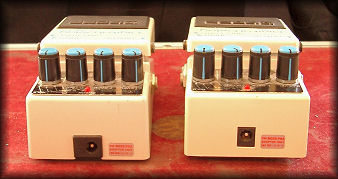I see these terms used a lot, but quite often they are used in the wrong fashion, or leading to the wrong conclusions. So let’s start with the power plugs in use out there, and the different ways they’re wired. From there, we’ll get into the various misconceptions (of which there are a few, as usual). Let’s see if we can straighten some of them out…
1/8″ (3.5mm) plug

In the early days, pedals didn’t normally have adapter jacks. Those that did used the 1/8″ (3.5mm) mini phone plug for the power connection. The jack in the pedal was normally secured right to the box, which also dictated the wiring – as the box itself is ground, the sleeve of the jack/plug had to be negative. So 1/8″ plugs are always wired tip positive. Because the metal neck and nut of the jack is connected to ground, you can sometimes see sparks when inserting the plug…

Aside from many old pedals, these days you’ll find this type of jack in the ProCo RAT (pictured), big box Electro-Harmonix pedals (BIg Muff NYC, Small Stone, Small Clone etc), the DOD 308 and Ibanez TS-808 among others. Also, Alesis used this plug in some of their 9vAC powered units. So if you find an adapter with a 1/8″ plug that says ”Alesis” on it, do not try it on your RAT – it will kill the pedal. For sure.
If you have a pedal that needs this type of connector, but only have normal DC plugs coming from your power supply or daisy chain cable, there are converter cables (google ”visual sound c35” and you’ll find one) available.
DC plugs (barrel type)

This is the most common type of plug used in guitar pedals. Boss started it all in the late ’70s, when they introduced it along with their relatively well known ”compact pedal” line, and other manufacturers followed suit. The adapter jack also needs to switch out the battery positive wire (to disconnect the battery when you insert a plug in the jack), and since the DC/barrel type jack has the switch on the sleeve/barrel connection, that’s where Boss wired the positive. The jack also has a center pin, so normal Boss jacks/plugs are therefore wired center negative. There’s no ”tip” on a DC/barrel plug, so the term ”negative tip” is not applicable.

DC plugs are (as mentioned) normally wired center negative, and the size is 2.1×5.5mm. The plug has a 5.5mm outer diameter, with a 2.1mm hole (to mate with the center pin in the jack). The jacks are easily recognizeable by the center pin, of course. I’ve borrowed a pic from the DD-3 page to illustrate what they look like. There are pedals where the jack is wired center positive – again, not ”positive tip” – and some of them need their own separate power source (because they are positive ground), while others will work fine from a common ground supply. As long as you get the polarity right, of course – if a pedal needs the positive on the center pin rather than the sleeve, that’s what you have to give it.
The DC plug – often with a slightly larger center pin – is also used for pedals that run on 9vAC (Digitech Whammy 1-4 and RP series, Line 6 xx-4, M13 etc). Sadly, that plug will fit in a regular DC powered pedal (as the hole for the center pin is larger), so be careful – if the power supply says 9vAC or similar (AC is often denoted with a squiggly line), do not plug it into a pedal that expects DC voltage! Again – that will kill the pedal. For sure.
So what about positive and negative tip, then?
Well, for starters, the only plug that actually has a tip is the 1/8″, and that one is always wired with the positive going to the tip. DC plugs have ”centers”, and are therefore negative or positive center.
Now, I often hear people say that you ”can’t mix positive and negative tip pedals”, as that will short the power out. This is not true… or rather, sometimes it is and sometimes it isn’t. Ignoring the ”tip” thing for now, just because a pedal has the power jack wired in reverse from what’s normal, doesn’t mean it can’t be powered alongside normal ones. You obviously need to get the plug polarity right (center negative or center positive), but if the pedal shorts the power out, it’s because it is positive ground – not because its power jack is wired differently.